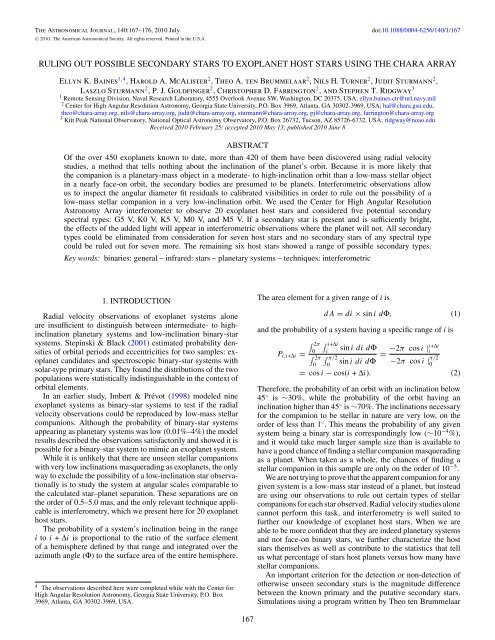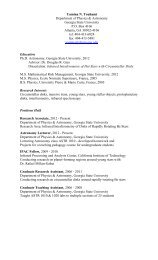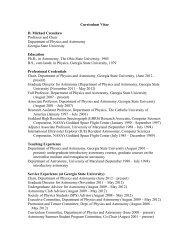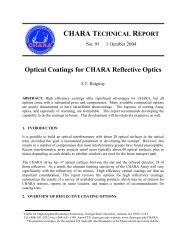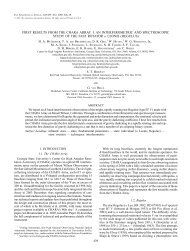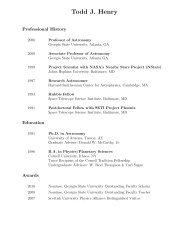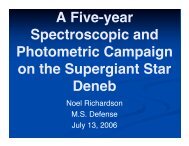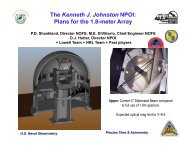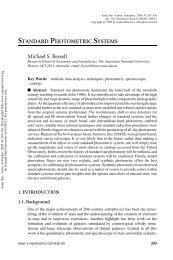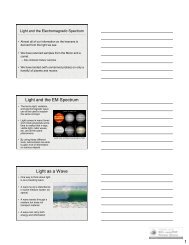ruling out possible secondary stars to exoplanet host stars using the ...
ruling out possible secondary stars to exoplanet host stars using the ...
ruling out possible secondary stars to exoplanet host stars using the ...
- No tags were found...
Create successful ePaper yourself
Turn your PDF publications into a flip-book with our unique Google optimized e-Paper software.
The Astronomical Journal, 140:167–176, 2010 JulyC○ 2010. The American Astronomical Society. All rights reserved. Printed in <strong>the</strong> U.S.A.doi:10.1088/0004-6256/140/1/167RULING OUT POSSIBLE SECONDARY STARS TO EXOPLANET HOST STARS USING THE CHARA ARRAYEllyn K. Baines 1,4 , Harold A. McAlister 2 , Theo A. ten Brummelaar 2 , Nils H. Turner 2 , Judit Sturmann 2 ,Laszlo Sturmann 2 , P. J. Goldfinger 2 , Chris<strong>to</strong>pher D. Farring<strong>to</strong>n 2 , and Stephen T. Ridgway 31 Remote Sensing Division, Naval Research Labora<strong>to</strong>ry, 4555 Overlook Avenue SW, Washing<strong>to</strong>n, DC 20375, USA; ellyn.baines.ctr@nrl.navy.mil2 Center for High Angular Resolution Astronomy, Georgia State University, P.O. Box 3969, Atlanta, GA 30302-3969, USA; hal@chara.gsu.edu,<strong>the</strong>o@chara-array.org, nils@chara-array.org, judit@chara-array.org, sturmann@chara-array.org, pj@chara-array.org, farring<strong>to</strong>n@chara-array.org3 Kitt Peak National Observa<strong>to</strong>ry, National Optical Astronomy Observa<strong>to</strong>ry, P.O. Box 26732, Tucson, AZ 85726-6732, USA; ridgway@noao.eduReceived 2010 February 25; accepted 2010 May 13; published 2010 June 8ABSTRACTOf <strong>the</strong> over 450 <strong>exoplanet</strong>s known <strong>to</strong> date, more than 420 of <strong>the</strong>m have been discovered <strong>using</strong> radial velocitystudies, a method that tells nothing ab<strong>out</strong> <strong>the</strong> inclination of <strong>the</strong> planet’s orbit. Because it is more likely that<strong>the</strong> companion is a planetary-mass object in a moderate- <strong>to</strong> high-inclination orbit than a low-mass stellar objectin a nearly face-on orbit, <strong>the</strong> <strong>secondary</strong> bodies are presumed <strong>to</strong> be planets. Interferometric observations allowus <strong>to</strong> inspect <strong>the</strong> angular diameter fit residuals <strong>to</strong> calibrated visibilities in order <strong>to</strong> rule <strong>out</strong> <strong>the</strong> possibility of alow-mass stellar companion in a very low-inclination orbit. We used <strong>the</strong> Center for High Angular ResolutionAstronomy Array interferometer <strong>to</strong> observe 20 <strong>exoplanet</strong> <strong>host</strong> <strong>stars</strong> and considered five potential <strong>secondary</strong>spectral types: G5 V, K0 V, K5 V, M0 V, and M5 V. If a <strong>secondary</strong> star is present and is sufficiently bright,<strong>the</strong> effects of <strong>the</strong> added light will appear in interferometric observations where <strong>the</strong> planet will not. All <strong>secondary</strong>types could be eliminated from consideration for seven <strong>host</strong> <strong>stars</strong> and no <strong>secondary</strong> <strong>stars</strong> of any spectral typecould be ruled <strong>out</strong> for seven more. The remaining six <strong>host</strong> <strong>stars</strong> showed a range of <strong>possible</strong> <strong>secondary</strong> types.Key words: binaries: general – infrared: <strong>stars</strong> – planetary systems – techniques: interferometric1. INTRODUCTIONRadial velocity observations of <strong>exoplanet</strong> systems aloneare insufficient <strong>to</strong> distinguish between intermediate- <strong>to</strong> highinclinationplanetary systems and low-inclination binary-<strong>stars</strong>ystems. Stepinski & Black (2001) estimated probability densitiesof orbital periods and eccentricities for two samples: <strong>exoplanet</strong>candidates and spectroscopic binary-star systems withsolar-type primary <strong>stars</strong>. They found <strong>the</strong> distributions of <strong>the</strong> twopopulations were statistically indistinguishable in <strong>the</strong> context oforbital elements.In an earlier study, Imbert & Prévot (1998) modeled nine<strong>exoplanet</strong> systems as binary-star systems <strong>to</strong> test if <strong>the</strong> radialvelocity observations could be reproduced by low-mass stellarcompanions. Although <strong>the</strong> probability of binary-star systemsappearing as planetary systems was low (0.01%–4%) <strong>the</strong> modelresults described <strong>the</strong> observations satisfac<strong>to</strong>rily and showed it is<strong>possible</strong> for a binary-star system <strong>to</strong> mimic an <strong>exoplanet</strong> system.While it is unlikely that <strong>the</strong>re are unseen stellar companionswith very low inclinations masquerading as <strong>exoplanet</strong>s, <strong>the</strong> onlyway <strong>to</strong> exclude <strong>the</strong> possibility of a low-inclination star observationallyis <strong>to</strong> study <strong>the</strong> system at angular scales comparable <strong>to</strong><strong>the</strong> calculated star–planet separation. These separations are on<strong>the</strong> order of 0.5–5.0 mas, and <strong>the</strong> only relevant technique applicableis interferometry, which we present here for 20 <strong>exoplanet</strong><strong>host</strong> <strong>stars</strong>.The probability of a system’s inclination being in <strong>the</strong> rangei <strong>to</strong> i + Δi is proportional <strong>to</strong> <strong>the</strong> ratio of <strong>the</strong> surface elemen<strong>to</strong>f a hemisphere defined by that range and integrated over <strong>the</strong>azimuth angle (Φ) <strong>to</strong> <strong>the</strong> surface area of <strong>the</strong> entire hemisphere.4 The observations described here were completed while with <strong>the</strong> Center forHigh Angular Resolution Astronomy, Georgia State University, P.O. Box3969, Atlanta, GA 30302-3969, USA.The area element for a given range of i isdA = di × sin idΦ, (1)and <strong>the</strong> probability of a system having a specific range of i is∫ 2π ∫ i+Δi0 i∫ 2π ∫ π/20sin ididΦ −2π cos i |i+ΔiiP i,i+Δi ==0sin ididΦ −2π cos i | π/20= cos i − cos(i + Δi). (2)Therefore, <strong>the</strong> probability of an orbit with an inclination below45 ◦ is ∼30%, while <strong>the</strong> probability of <strong>the</strong> orbit having aninclination higher than 45 ◦ is ∼70%. The inclinations necessaryfor <strong>the</strong> companion <strong>to</strong> be stellar in nature are very low, on <strong>the</strong>order of less than 1 ◦ . This means <strong>the</strong> probability of any givensystem being a binary star is correspondingly low (∼10 −4 %),and it would take much larger sample size than is available <strong>to</strong>have a good chance of finding a stellar companion masqueradingas a planet. When taken as a whole, <strong>the</strong> chances of finding astellar companion in this sample are only on <strong>the</strong> order of 10 −5 .We are not trying <strong>to</strong> prove that <strong>the</strong> apparent companion for anygiven system is a low-mass star instead of a planet, but insteadare <strong>using</strong> our observations <strong>to</strong> rule <strong>out</strong> certain types of stellarcompanions for each star observed. Radial velocity studies alonecannot perform this task, and interferometry is well suited <strong>to</strong>fur<strong>the</strong>r our knowledge of <strong>exoplanet</strong> <strong>host</strong> <strong>stars</strong>. When we areable <strong>to</strong> be more confident that <strong>the</strong>y are indeed planetary systemsand not face-on binary <strong>stars</strong>, we fur<strong>the</strong>r characterize <strong>the</strong> <strong>host</strong><strong>stars</strong> <strong>the</strong>mselves as well as contribute <strong>to</strong> <strong>the</strong> statistics that tellus what percentage of <strong>stars</strong> <strong>host</strong> planets versus how many havestellar companions.An important criterion for <strong>the</strong> detection or non-detection ofo<strong>the</strong>rwise unseen <strong>secondary</strong> <strong>stars</strong> is <strong>the</strong> magnitude differencebetween <strong>the</strong> known primary and <strong>the</strong> putative <strong>secondary</strong> <strong>stars</strong>.Simulations <strong>using</strong> a program written by Theo ten Brummelaar167
168 BAINES ET AL. Vol. 140that realistically models instrumental and atmospheric noises,as well as observations of pairs of known brightness contrasts,indicate that <strong>the</strong> Array is sensitive <strong>to</strong> a magnitude difference in<strong>the</strong> K band (ΔK) of 3.0. Therefore, if a second star is presentand is not more than ∼3.0 mag fainter than <strong>the</strong> <strong>host</strong> star, <strong>the</strong>effects of <strong>the</strong> second star will be seen in <strong>the</strong> interferometric data.It should be noted that a limiting magnitude difference in <strong>the</strong> Kband (ΔK) of 3.0 is a lower limit, as <strong>the</strong> true ΔK also dependson <strong>the</strong> absolute brightness of <strong>the</strong> two <strong>stars</strong> and could be slightlyhigher for some systems.This technique of <strong>using</strong> interferometric observations <strong>to</strong> eliminate<strong>the</strong> possibility of certain types of <strong>secondary</strong> <strong>stars</strong> was employed<strong>to</strong> examine <strong>the</strong> <strong>exoplanet</strong> <strong>host</strong> star 51 Peg (HD 217014)by Boden et al. (1998), whose analysis of Palomar Testbed Interferometerdata supported a single-star model for that star. Theyfit single-star and binary-star models <strong>to</strong> <strong>the</strong> data and found thatany <strong>possible</strong> unseen stellar companion would have <strong>to</strong> have aK-magnitude fainter than 7.30 and a mass of less than 0.22 M ⊙ .Here, we describe our interferometric observations, ourmethod for choosing calibra<strong>to</strong>r <strong>stars</strong>, and define <strong>the</strong> role interferometricresolution plays in Section 2. In Section 3, wediscuss how <strong>the</strong> angular diameter fit residuals <strong>to</strong> calibrated visibilitiescan help us eliminate certain types of <strong>secondary</strong> <strong>stars</strong>;and Section 4 explores <strong>the</strong> implications of <strong>the</strong> observations. Thispaper is follow-on work <strong>to</strong> an earlier study (Baines et al. 2008b).2. INTERFEROMETRIC OBSERVATIONSAll observations were obtained <strong>using</strong> <strong>the</strong> Center for HighAngular Resolution Astronomy (CHARA) Array, a six-elemen<strong>to</strong>ptical/infrared interferometric array located on Mount Wilson,CA (ten Brummelaar et al. 2005). We used <strong>the</strong> pupil-plane“CHARA Classic” beam combiner in <strong>the</strong> K ′ band (2.133 μmcenter with a 0.349 μm width), while visible wavelengths(470–800 nm) were used for tracking and tip/tilt corrections.The observing procedure and data reduction process employedhere are described in McAlister et al. (2005). The observablequantity from an interferometer is <strong>the</strong> fringe contrast or “visibility”of <strong>the</strong> observed target, and each data set consists ofapproximately 200 scans across <strong>the</strong> fringe.Our target list was selected from <strong>the</strong> complete <strong>exoplanet</strong> listby <strong>using</strong> declination limits and magnitude constraints: north of−10 ◦ declination, brighter than V = +10 in order for <strong>the</strong> tip/tilt system <strong>to</strong> lock on<strong>to</strong> <strong>the</strong> star, and brighter than K = +6.5for reliable fringe detection with a sufficiently high signal-<strong>to</strong>noiseratio. We obtained data on <strong>the</strong> 20 <strong>exoplanet</strong> <strong>host</strong> <strong>stars</strong>between 2005 Oc<strong>to</strong>ber and 2008 September. The observationswere taken <strong>using</strong> mostly <strong>the</strong> longest baseline available on <strong>the</strong>CHARA Array (331 m), though 156 m and 249 m baselineswere also used.Reliable calibra<strong>to</strong>rs <strong>stars</strong> are critical in interferometric observations,acting as <strong>the</strong> standard against which <strong>the</strong> sciencetarget is measured, and <strong>the</strong> ideal calibra<strong>to</strong>r is a single, spherical,non-variable star. Our observing pattern was calibra<strong>to</strong>r-targetcalibra<strong>to</strong>rso that every target was bracketed by calibra<strong>to</strong>r observationsmade as close in time as <strong>possible</strong>; <strong>the</strong>refore, “fivebracketed observations” denote five target and six calibra<strong>to</strong>rdata sets. The target–calibra<strong>to</strong>r (T–C) distances ranged from 1 ◦<strong>to</strong> 9 ◦ and 13 calibra<strong>to</strong>rs were within 4 ◦ of <strong>the</strong>ir target <strong>stars</strong>.This allowed us <strong>to</strong> observe <strong>the</strong> <strong>stars</strong> as close <strong>to</strong>ge<strong>the</strong>r in timeas <strong>possible</strong>, usually on <strong>the</strong> order of 3–5 minutes between <strong>the</strong>two, <strong>the</strong>refore, reducing <strong>the</strong> effects of changing seeing conditionsas much as <strong>possible</strong>. Table 1 lists <strong>the</strong> <strong>exoplanet</strong> <strong>host</strong> <strong>stars</strong>observed, <strong>the</strong>ir calibra<strong>to</strong>rs, <strong>the</strong> dates of <strong>the</strong> observations, <strong>the</strong>Table 1Observing LogTarget Calibra<strong>to</strong>r Baseline Date No. T–C SepHD HD (max. length) (UT) Obs (deg)10697 10477 S1–E1 (331 m) 2005 Oct 23 4 42007 Sep 14 413189 11007 S1–E1 (331 m) 2005 Dec 12 4 42006 Aug 14 432518 31675 S1–E1 (331 m) 2007 Nov 14 9 345410 46590 S1–E1 (331 m) 2008 Sep 11 5 250554 49736 S1–E1 (331 m) 2005 Dec 12 5 273108 69548 E2–W2 (156 m) 2008 May 9 5 7136726 145454 E2–W2 (156 m) 2008 May 9 6 6139357 132254 S1–E1 (331 m) 2007 Sep 14 4 7145675 151044 S1–E1 (331 m) 2006 Aug 12 6 8154345 151044 S1–E1 (331 m) 2008 Sep 10 7 4164922 159139 S1–E1 (331 m) 2008 Aug 11 5 7167042 161693 S1–E1 (331 m) 2007 Sep 15 8 4170693 172569 W1–S2 (249 m) 2007 Sep 3 4 1185269 184381 S1–E1 (331 m) 2008 Jul 18 15 32008 Jul 20 5188310 182101 S1–E1 (331 m) 2008 Sep 8 8 8199665 194012 S1–E1 (331 m) 2008 Sep 8 10 9210702 210074 S1–E1 (331 m) 2008 Sep 8 4 4217107 217131 S1–E1 (331 m) 2008 Sep 8 5 1221345 222451 S1–E1 (331 m) 2008 Sep 11 5 3222404 219485 S1–E1 (331 m) 2008 Sep 11 7 4Notes. The three arms of <strong>the</strong> Array are denoted by <strong>the</strong>ir cardinal directions: “S”is s<strong>out</strong>h, “E” is east, and “W” is west. Each arm bears two telescopes, numbered“1” for <strong>the</strong> telescope far<strong>the</strong>st from <strong>the</strong> beam combining labora<strong>to</strong>ry and “2” for<strong>the</strong> telescope closer <strong>to</strong> <strong>the</strong> lab.baseline used, <strong>the</strong> number of observations obtained, and <strong>the</strong>T–C distance.In order <strong>to</strong> check for excess emission that could indicate a lowmassstellar companion or circumstellar disk, we fitted spectralenergy distributions (SEDs) based on published UBVRIJHKpho<strong>to</strong>metric values for each calibra<strong>to</strong>r star. Limb-darkeneddiameters were calculated <strong>using</strong> Kurucz model atmospheres 5based on effective temperature and gravity values obtained from<strong>the</strong> literature. The models were <strong>the</strong>n fit <strong>to</strong> observed pho<strong>to</strong>metricvalues also from <strong>the</strong> literature after converting magnitudes <strong>to</strong>fluxes <strong>using</strong> Colina et al. (1996) forUBVRI values and Cohenet al. (2003) forJHK values.Many of <strong>the</strong> calibra<strong>to</strong>r <strong>stars</strong> chosen here had been used ascomparison or calibra<strong>to</strong>r <strong>stars</strong> in o<strong>the</strong>r studies, or speckle studiesdid not find companions (see Table 2). For those calibra<strong>to</strong>r <strong>stars</strong>that had not been previously observed, <strong>the</strong>ir SED fits showed noexcess flux that could indicate a stellar companion that would<strong>the</strong>n contaminate our interferometric observations.Our ability <strong>to</strong> detect stellar companions depends on two mainfac<strong>to</strong>rs. The first is <strong>the</strong> precision of our visibility measurements.The higher <strong>the</strong> precision, <strong>the</strong> higher our sensitivity <strong>to</strong> findinga <strong>secondary</strong> companion. The second fac<strong>to</strong>r is whe<strong>the</strong>r <strong>the</strong>measured angular diameters or potential primary–<strong>secondary</strong>separation would be resolved in our data. The resolution of aninterferometer depends on <strong>the</strong> wavelength used and <strong>the</strong> distancebetween <strong>the</strong> telescopes, o<strong>the</strong>rwise known as <strong>the</strong> baseline. A staris considered unresolved if its visibility is ∼ =1 and is completelyresolved when its visibilities drop <strong>to</strong> zero. Differently sized <strong>stars</strong>will be resolved at different baselines (see Figure 1).5 See http://kurucz.cfa.harvard.edu.
No. 1, 2010 EXOPLANET HOST STAR COMPANIONS 169Figure 1. Effect of various stellar angular diameters on <strong>the</strong> visibility curve. The smaller a star’s angular diameter, <strong>the</strong> less change is seen in <strong>the</strong> visibility curve as afunction of baseline.Table 2Notes on Calibra<strong>to</strong>r Quality and Previous UsesHDDetails10477 No sign of duplicity in literature or SED fit11007 Listed as a “suitable” calibra<strong>to</strong>r in van Belle et al. (2008);used as calibra<strong>to</strong>r in Konacki & Lane (2004)31675 No companion found <strong>using</strong> speckle in McAlister et al. (1989)46590 No sign of duplicity in literature or SED fit49736 No sign of duplicity in literature or SED fit69548 No sign of duplicity in literature or SED fit132254 Listed as a “probably suitable” calibra<strong>to</strong>r in van Belle et al. (2008);no companion found <strong>using</strong> speckle in McAlister et al. (1989)145454 No sign of duplicity in literature or SED fit151044 Listed as a “probably suitable” calibra<strong>to</strong>r in van Belle et al. (2008)159139 No companion found <strong>using</strong> speckle in McAlister et al. (1987)161693 No companion found <strong>using</strong> speckle in McAlister et al. (1987)172569 Listed in “HIP Visual Binaries Kinematics” table by Bartkevicius & Gudas (2001);but no o<strong>the</strong>r information given in paper or general literature182101 Used as calibra<strong>to</strong>r in Berger et al. (2006)184381 Used as comparison star in Johnson et al. (2006)194012 Listed as a “suitable” calibra<strong>to</strong>r in van Belle et al. (2008);no companion found <strong>using</strong> speckle in McAlister et al. (1987)210074 Listed as a “suitable” calibra<strong>to</strong>r in van Belle et al. (2008);used as comparison star in Wittenmyer et al. (2005)217131 No companion found <strong>using</strong> speckle in McAlister et al. (1987)219485 No sign of duplicity in literature or SED fit222451 No sign of duplicity in literature or SED fitAno<strong>the</strong>r effect <strong>to</strong> account for is bandwidth smearing, whichoccurs when <strong>the</strong> physical width of <strong>the</strong> filter’s bandpass affects<strong>the</strong> measurements as <strong>the</strong> resolution varies across <strong>the</strong> band.Bandwidth smearing is only significant when a star’s angulardiameter exceeds <strong>the</strong> coherent field of view of <strong>the</strong> interferometer,which is calculated <strong>to</strong> beFOV = θ minπ( Δλλ 0) −1, (3)
170 BAINES ET AL. Vol. 140Table 3Exoplanet Host Stars’ Calibrated VisibilitiesTarget MJD B Θ V c σV c %Name (m) (deg) Error10697 53666.427 309.50 175.2 1.043 0.090 953666.443 310.79 171.2 0.928 0.068 753666.456 312.37 167.9 1.004 0.104 1053666.470 314.46 164.6 0.832 0.075 954356.765 317.17 226.9 0.883 0.103 1254356.775 320.54 227.4 1.029 0.125 1254357.783 323.64 228.1 0.851 0.077 954357.792 325.84 228.8 0.723 0.068 954357.802 327.87 229.7 0.816 0.089 1154357.810 328.95 230.4 0.791 0.061 813189 53716.270 327.09 184.4 0.607 0.056 953716.285 326.91 180.9 0.531 0.081 1553716.298 326.96 177.7 0.589 0.095 1653716.312 327.21 174.3 0.575 0.130 2353961.441 326.60 216.4 0.622 0.051 853961.454 328.41 214.4 0.648 0.062 1053961.467 329.65 212.2 0.643 0.073 1153961.481 330.38 209.8 0.607 0.040 732518 54418.238 230.84 200.1 0.755 0.067 954418.244 233.56 201.8 0.794 0.071 954418.250 236.48 203.6 0.834 0.070 854418.256 239.18 205.3 0.843 0.074 954418.261 241.66 206.9 0.751 0.061 854418.267 244.20 208.6 0.743 0.053 754418.274 246.86 210.3 0.776 0.059 854418.280 249.36 212.0 0.741 0.065 954418.286 251.81 213.8 0.732 0.053 745410 54720.481 258.11 212.9 0.696 0.078 1154720.490 263.24 215.0 0.651 0.053 854720.496 266.69 216.4 0.587 0.073 1254720.502 269.68 217.7 0.665 0.106 1654720.509 272.90 219.2 0.716 0.097 1450554 53711.523 317.33 174.2 0.874 0.127 1553711.537 318.32 170.7 0.783 0.090 1153716.422 321.04 195.4 1.006 0.138 1453716.435 319.48 192.2 0.905 0.091 1053716.449 318.20 189.0 0.984 0.083 853716.463 317.30 185.7 1.027 0.096 953716.479 316.73 181.7 0.956 0.150 1673108 54595.216 155.95 254.7 0.411 0.051 1254595.226 155.88 258.0 0.446 0.034 854595.235 155.83 261.1 0.436 0.043 1054595.244 155.80 264.1 0.460 0.057 1254595.257 155.77 268.4 0.430 0.092 21136726 54595.294 147.57 189.4 0.442 0.055 1254595.307 148.79 193.7 0.425 0.045 1154595.315 149.53 196.5 0.468 0.054 1254595.325 150.30 199.6 0.421 0.056 1354595.336 151.17 203.4 0.436 0.062 1454595.346 151.80 206.5 0.409 0.053 13139357 54357.149 320.57 102.8 0.450 0.070 1654357.155 320.14 104.2 0.460 0.045 1054357.161 319.66 105.6 0.487 0.063 1354357.167 319.12 107.1 0.491 0.066 1354358.151 320.24 103.9 0.460 0.030 754358.157 319.77 105.3 0.415 0.034 854358.162 319.27 106.7 0.429 0.049 11145675 53958.259 329.81 168.4 0.902 0.054 653958.275 329.38 164.9 0.878 0.045 553958.292 328.62 161.0 0.859 0.051 653959.168 329.99 189.3 1.096 0.123 1153959.184 330.18 185.5 1.000 0.089 953959.200 330.26 181.8 0.964 0.069 753959.215 330.26 178.1 0.990 0.070 753959.231 330.18 174.5 0.940 0.078 8Table 3(Continued)Target MJD B Θ V c σV c %Name (m) (deg) Error53959.246 330.01 170.9 0.954 0.067 753959.261 329.70 167.4 0.808 0.064 8154345 54719.168 328.79 90.5 0.885 0.094 1154719.179 328.73 93.3 0.843 0.109 1354719.185 328.66 94.7 0.811 0.089 1154719.192 328.57 96.2 0.803 0.096 1254719.198 328.45 97.6 0.847 0.096 1154719.204 328.29 99.2 0.903 0.095 1154719.213 328.00 101.4 0.817 0.122 15164922 54689.201 326.49 248.8 0.663 0.089 1354689.212 325.27 251.2 0.820 0.058 754689.223 324.07 253.6 0.957 0.079 854689.235 322.84 256.4 1.067 0.153 1454689.248 321.74 259.4 1.011 0.170 17167042 54358.232 321.20 97.5 0.584 0.037 654358.238 320.96 99.0 0.551 0.036 754358.243 320.68 100.3 0.507 0.036 754358.249 320.34 101.7 0.524 0.030 654358.255 319.96 103.1 0.571 0.036 654358.261 319.53 104.5 0.612 0.037 654358.267 319.05 105.9 0.591 0.041 754358.273 318.48 107.4 0.627 0.050 8170693 54346.303 187.40 183.8 0.373 0.042 1154346.311 183.87 186.6 0.343 0.049 1454346.321 179.32 190.2 0.358 0.037 1054346.332 174.70 193.9 0.457 0.042 9185269 54665.204 321.00 228.6 0.860 0.146 1754665.216 323.97 230.0 0.946 0.129 1454665.226 326.17 231.3 0.757 0.148 2054665.236 327.81 232.6 0.926 0.110 1254665.245 328.96 233.9 0.928 0.178 1954665.404 323.06 266.1 0.771 0.064 854665.410 322.92 267.7 0.741 0.050 754665.417 322.85 269.2 0.816 0.048 654665.423 322.85 90.8 0.921 0.057 654665.430 322.93 92.4 0.877 0.075 954665.438 323.11 94.3 0.912 0.084 954665.445 323.35 96.0 0.910 0.091 1054665.452 323.68 97.7 0.855 0.080 954665.459 324.06 99.4 0.927 0.083 954665.466 324.52 101.1 0.841 0.129 1554667.381 323.73 262.0 1.004 0.096 1054667.387 323.44 263.5 0.830 0.103 1254667.393 323.21 264.9 0.892 0.096 1154667.400 323.02 266.5 1.014 0.085 854667.406 322.90 267.9 0.899 0.113 13188310 54717.211 293.54 249.5 0.103 0.014 1454717.223 289.87 252.2 0.106 0.017 1654717.229 288.10 253.7 0.107 0.012 1154717.236 286.11 255.5 0.106 0.014 1354717.242 284.72 257.0 0.094 0.015 1654717.248 283.37 258.5 0.110 0.019 1754717.253 282.29 260.0 0.111 0.018 1654717.259 281.25 261.6 0.127 0.018 14199665 54717.336 285.96 90.6 0.614 0.064 1054717.341 286.09 92.1 0.567 0.062 1154717.347 286.36 93.6 0.562 0.077 1454717.352 286.78 95.0 0.574 0.053 954717.358 287.37 96.6 0.566 0.060 1154717.364 288.15 98.2 0.512 0.055 1154717.370 289.11 99.1 0.479 0.069 1454717.377 290.31 101.5 0.482 0.049 1054717.383 291.58 103.1 0.414 0.035 854717.390 293.30 104.9 0.500 0.065 13210702 54717.426 302.96 100.6 0.635 0.076 12
No. 1, 2010 EXOPLANET HOST STAR COMPANIONS 171Table 3(Continued)Target MJD B Θ V c σV c %Name (m) (deg) Error54717.436 304.66 103.1 0.652 0.072 1154717.442 305.68 104.5 0.591 0.085 1454717.448 306.87 105.9 0.640 0.091 14217107 54717.283 292.41 236.3 0.771 0.096 1254717.289 289.09 237.2 0.793 0.127 1654717.296 285.35 238.3 0.757 0.095 1354717.303 281.40 239.5 0.799 0.118 1554717.309 278.11 240.6 0.776 0.114 15221345 54720.234 313.74 229.1 0.278 0.031 1154720.239 315.41 229.9 0.253 0.034 1354720.245 317.13 230.8 0.266 0.028 1154720.250 318.64 231.7 0.232 0.024 1054720.256 320.12 232.7 0.251 0.028 11222404 54664.457 253.07 230.4 0.105 0.011 1054664.466 254.63 233.0 0.099 0.011 1154664.475 256.07 235.6 0.091 0.010 1154720.278 247.87 222.5 0.104 0.012 1254720.285 249.26 224.5 0.093 0.010 1154720.295 251.32 227.6 0.093 0.008 954720.301 252.45 229.3 0.086 0.008 954720.307 253.58 231.2 0.092 0.009 1054720.313 254.70 233.2 0.091 0.008 954720.320 255.83 235.2 0.087 0.009 10Note. The projected baseline position angle (Θ) is calculated <strong>to</strong> be east of north.where θ min = λ 0 /B and B is <strong>the</strong> baseline, λ 0 is <strong>the</strong> centralwavelength of <strong>the</strong> filter, and Δλ is <strong>the</strong> width of <strong>the</strong> filter (Tango&Davis2002). Because our coherent FOV is larger than <strong>the</strong>measured angular diameters in all cases, we do not need <strong>to</strong>correct for this effect when measuring our primary <strong>exoplanet</strong><strong>host</strong> <strong>stars</strong>. On <strong>the</strong> o<strong>the</strong>r hand, when we determine <strong>the</strong> visibilitiesfor binary systems that have calculated separations larger than<strong>the</strong> FOV, we need <strong>to</strong> account for bandwidth smearing by <strong>using</strong>a modified version of <strong>the</strong> visibility equation for binary <strong>stars</strong>.3. CHARACTERIZING ANGULAR DIAMETER FITRESIDUALS TO CALIBRATED VISIBILITIESTo determine stellar angular diameters, measured visibilities(V) are fit <strong>to</strong> a model of a uniformly illuminated disk (UD).Single-star diameter fits <strong>to</strong> V were based upon <strong>the</strong> UD approximationgiven by V = [2J 1 (x)]/x, where J 1 is <strong>the</strong> first-orderBessel function and x = πBθ UD λ −1 , where B is <strong>the</strong> projectedbaseline at <strong>the</strong> star’s position, θ UD is <strong>the</strong> apparent UD angulardiameter of <strong>the</strong> star, and λ is <strong>the</strong> effective wavelength of <strong>the</strong>observation (Shao & Colavita 1992). A more realistic modelof a star’s disk involves limb-darkening (LD), and <strong>the</strong> relationshipincorporating <strong>the</strong> linear limb-darkening coefficient μ λ(Hanbury-Brown et al. 1974) isV =(1 − μ λ2(π+ μ λ2) −1×[+ μ λ3) 1/2 ]J3/2 (x). (4)x 3/2(1 − μ λ ) J 1(x)xTable 3 lists <strong>the</strong> Modified Julian Date (MJD), baseline B,projected baseline position angle (Θ), calibrated visibility (V c ),and error in V c (σV c ) for each star observed, and <strong>the</strong> resultingangular diameters are presented in Table 4. Figure 2 shows<strong>the</strong> LD diameter fit for HD 164922 as this star’s diameter ispresented for <strong>the</strong> first time here. Similar plots for <strong>the</strong> remaining<strong>stars</strong> can be found in <strong>the</strong> references listed in Table 4.The systematics in <strong>the</strong> residuals of <strong>the</strong> angular diameter fit<strong>to</strong> measured visibilities can help us eliminate certain types ofpotential <strong>secondary</strong> <strong>stars</strong>. The smaller <strong>the</strong> residuals, <strong>the</strong> lower<strong>the</strong> chance of an unseen stellar companion. For each <strong>exoplanet</strong><strong>host</strong> star observed, a variety of <strong>secondary</strong> <strong>stars</strong> were considered:G5 V, K0 V, K5 V, M0 V, and M5 V. The magnitude difference(ΔM K , listed as ΔK in <strong>the</strong> tables) and angular separation (α)of a face-on orbit between <strong>the</strong> <strong>host</strong> star and companion werecalculated for each <strong>possible</strong> pairing:ΔM K = M s +(m h − M h ) − m h , (5)where M h,s are <strong>the</strong> absolute magnitudes of <strong>the</strong> <strong>host</strong> star andpotential <strong>secondary</strong>, respectively, m h is <strong>the</strong> apparent magnitudeof <strong>the</strong> <strong>host</strong> star, and( ) 100(m h − M h ) = 5log , (6)πwhere π is <strong>the</strong> <strong>host</strong> star’s parallax in milliarcsecond (mas). Anestimate of <strong>the</strong> angular separation α in mas was calculated fromKepler’s third law:α = [(M h + M s ) × P 2 ] 1 3 × π, (7)where M h,s are <strong>the</strong> masses in M ⊙ of <strong>the</strong> <strong>exoplanet</strong>’s <strong>host</strong> star andpotential <strong>secondary</strong> star, respectively, and P is <strong>the</strong> companion’sorbital period in years.The angular diameter (θ) for each <strong>possible</strong> <strong>secondary</strong> starwas estimated <strong>using</strong> <strong>the</strong> calibration of radius as a function ofspectral type from Cox (2000) and <strong>the</strong> parallax of <strong>the</strong> <strong>host</strong>star. The masses and radii in Cox are based on values derivedfrom Habets & Heintze (1981), who observed binary <strong>stars</strong> inorder <strong>to</strong> create empirical relationships between various stellarparameters as a function of luminosity class. Tables 4 and 5present <strong>the</strong> results of <strong>the</strong>se calculations.The resulting values for θ, ΔK, and α were <strong>the</strong>n used <strong>to</strong>determine <strong>the</strong> visibility curve for a single star with <strong>the</strong> <strong>host</strong>star’s measured angular diameter as well as for a binary systemwith <strong>the</strong> parameters listed above. The equation used <strong>to</strong> calculate<strong>the</strong> visibility curve for a binary system when observed <strong>using</strong> anarrow bandpass isV = (1 + β) −1[ V 21 + β2 V 22 +2βV 1V 2 cos{2πBλ −1 α cos φ} ] 1 2,(8)where V 1,2 are <strong>the</strong> visibilities for <strong>the</strong> primary and <strong>secondary</strong>star, respectively, β = 100 0.2Δm , where Δm is <strong>the</strong> magnitudedifference between <strong>the</strong> two <strong>stars</strong>, and φ is <strong>the</strong> difference of <strong>the</strong>position angles between <strong>the</strong> binary and <strong>the</strong> baseline (HanburyBrown et al. 1970). Because <strong>the</strong> observations described herewere taken <strong>using</strong> a filter with a bandpass of ∼16%, <strong>the</strong> equationneeds <strong>to</strong> be modified <strong>to</strong> include <strong>the</strong> effects of wide bandwidthand bandwidth smearing (North et al. 2007):V = (1 + β) −1[ V 21 + β2 V 22 +2βr(ψ)V 1V 2 cos ψ ] 1 2, (9)where ψ = 2πBλ −1 α cos φ and( −Δλ2ψ 2 )r(ψ) = exp. (10)32 ln 2λ 2 0
172 BAINES ET AL. Vol. 140Figure 2. HD 164922 LD disk diameter fit. The solid line represents <strong>the</strong> <strong>the</strong>oretical visibility curve for <strong>the</strong> star with <strong>the</strong> best-fit θ LD , <strong>the</strong> dashed lines are <strong>the</strong> 1σ errorlimits of <strong>the</strong> diameter fit, <strong>the</strong> squares are <strong>the</strong> calibrated visibilities, and <strong>the</strong> vertical lines are <strong>the</strong> measured errors.Table 4Exoplanet Host Star and Planet Observed ParametersHD Observed Stellar Parameters Planetary System Parameters (m − M)Spectral θ LD σ LD K π M star P ReferenceType (mas) (%) (mag) (mas) (M ⊙ ) (d)10697 G5 IV 0.49 ± 0.05 a 10 4.60 ± 0.02 30.70 ± 0.43 1.2 1076.4 Butler et al. (2006) 2.613189 K2 0.84 ± 0.03 a 4 4.00 ± 0.03 1.78 ± 0.73 3.5 b 472 P from Hatzes et al. (2005) 8.732518 K1 III 0.85 ± 0.02 c 2 3.91 ± 0.04 8.29 ± 0.58 1.1 157.5 Döllinger et al. (2009a) 5.445410 K0 III-IV 0.97 ± 0.04 d 4 3.70 ± 0.30 17.92 ± 0.47 1.7 889 Sa<strong>to</strong> et al. (2008b) 3.750554 F8 V 0.34 ± 0.10 a 29 5.47 ± 0.02 33.43 ± 0.59 1.1 1254 Fischer et al. (2002) 2.473108 K1 III 2.23 ± 0.02 c 1 1.92 ± 0.07 12.74 ± 0.26 1.2 269.3 Döllinger et al. (2007) 4.5136726 K4 III 2.34 ± 0.02 c 1 1.92 ± 0.05 8.19 ± 0.19 1.8 516.2 Döllinger et al. (2009a) 5.4139357 K4 III 1.07 ± 0.01 c 1 3.41 ± 0.32 8.47 ± 0.30 1.3 1125.7 Döllinger et al. (2009b) 5.4145675 K0 V 0.37 ± 0.04 a 11 4.71 ± 0.02 56.91 ± 0.34 1.0 1724.0 Butler et al. (2003) 1.2154345 G8 V 0.50 ± 0.03 d 6 5.00 ± 0.02 53.80 ± 0.32 0.9 3360 Wright et al. (2008) 1.3164922 K0 V 0.50 ± 0.07 e 14 5.11 ± 0.02 45.21 ± 0.54 0.9 1155 Butler et al. (2006) 1.7167042 K1 III 0.92 ± 0.02 c 2 3.55 ± 0.24 19.91 ± 0.26 1.5 418 Sa<strong>to</strong> et al. (2008b) 3.5170693 K1.5 III 2.04 ± 0.04 c 2 1.95 ± 0.05 10.36 ± 0.20 1.0 479.1 Döllinger et al. (2009b) 4.9185269 G0 IV 0.48 ± 0.03 d 6 5.26 ± 0.02 19.89 ± 0.56 1.3 6.8 Johnson et al. (2006) 3.5188310 G9 III 1.73 ± 0.01 d 1 2.17 ± 0.22 17.77 ± 0.29 2.2 137 Sa<strong>to</strong> et al. (2008a) 3.8199665 G6 III 1.11 ± 0.03 d 3 3.37 ± 0.20 13.28 ± 0.31 2.2 993 Sa<strong>to</strong> et al. (2008a) 4.4210702 K1 III 0.88 ± 0.02 d 2 3.98 ± 0.29 18.20 ± 0.39 1.9 341.1 Johnson et al. (2007) 3.7217107 G8 IV 0.70 ± 0.01 d 1 4.54 ± 0.02 50.36 ± 0.38 1.0 7.1 Fischer et al. (1999) 1.5221345 G8 III 1.34 ± 0.01 d 1 2.33 ± 0.24 12.63 ± 0.27 2.2 186 Sa<strong>to</strong> et al. (2008b) 4.5222404 K1 IV 3.30 ± 0.03 d 1 1.04 ± 0.21 70.91 ± 0.40 1.6 906 Hatzes et al. (2003) 0.7Notes. Spectral types are from SIMBAD; parallaxes π are from van Leeuwen (2007); K magnitudes are from Cutri et al. (2003), except for HD 73108, HD 136726,and HD 170693, which are from Neugebauer & Leigh<strong>to</strong>n (1969); (m − M) was calculated <strong>using</strong> Equation (3).a Baines et al. (2008a).b Mass from Schuler et al. (2005), though <strong>the</strong>y cannot constrain <strong>the</strong> mass <strong>to</strong> better than 2–6 M ⊙ .c Baines et al. (2010).d Baines et al. (2009).e Previously unpublished.To explore <strong>the</strong> effects of <strong>the</strong> projected position angle of a binarystarvec<strong>to</strong>r separation, we calculated <strong>the</strong> residuals <strong>using</strong> positionangles of 0 ◦ ,30 ◦ , and 60 ◦ (see Table 6).To estimate <strong>the</strong> detection sensitivity, <strong>the</strong> largest differencebetween <strong>the</strong> visibility curves for a single star and for a binarysystem with <strong>the</strong> parameters listed in Table 5 was calculated.This quantity, ΔV max , <strong>the</strong>n represented <strong>the</strong> maximum deviationof <strong>the</strong> binary visibility curve from <strong>the</strong> single-star curve. Figure 3shows an example of this.Due <strong>to</strong> uncertainties in such input parameters as <strong>the</strong> <strong>host</strong>star’s mass, parallax, and <strong>the</strong> planet’s orbital period used inEquations (3) and (4), we did not believe a 1σ threshold would
No. 1, 2010 EXOPLANET HOST STAR COMPANIONS 173Figure 3. Example of <strong>the</strong> difference between <strong>the</strong> visibility curves for a single star and a binary system. The solid line indicates <strong>the</strong> curve for a single star with θ = 1.0mas, while <strong>the</strong> dashed line represents <strong>the</strong> curve for a binary system with <strong>the</strong> following parameters: θ primary = 1.0 mas, θ <strong>secondary</strong> = 0.5 mas, α = 10 mas, and ΔK =2.0. ΔV max is <strong>the</strong> maximum deviation between <strong>the</strong> two curves.Table 5Calculated Parameters for Secondary Stars of Various Spectral TypesHD G5 V K0 V K5 V M0 V M5 VΔK α θ ΔK α θ ΔK α θ ΔK α θ ΔK α θ(mag) (mas) (mas) (mag) (mas) (mas) (mag) (mas) (mas) (mag) (mas) (mas) (mag) (mas) (mas)10697 1.5 80.6 0.26 1.9 78.8 0.24 2.5 77.2 0.21 3.1 74.9 0.17 4.1 70.1 0.0813189 8.3 3.5 0.02 8.7 3.4 0.01 9.3 3.4 0.01 9.9 3.4 0.01 10.9 3.3 0.0032518 5.0 6.0 0.07 5.4 5.9 0.07 6.0 5.8 0.06 6.6 5.6 0.05 7.6 5.2 0.0245410 3.5 44.7 0.15 3.9 43.9 0.14 4.5 43.2 0.12 5.2 42.2 0.10 6.2 40.2 0.0550554 0.4 95.6 0.29 0.8 93.5 0.26 1.4 91.4 0.22 2.1 88.5 0.19 3.0 82.5 0.0873108 6.1 13.4 0.11 6.5 13.1 0.10 7.1 12.9 0.09 7.7 12.5 0.07 8.7 11.7 0.03136726 7.0 14.4 0.07 7.4 14.2 0.06 8.0 13.9 0.05 8.7 13.6 0.05 9.6 13.0 0.02139357 5.5 23.4 0.07 5.9 23.0 0.07 6.5 22.5 0.06 7.1 21.9 0.05 8.1 20.6 0.02145675 0.0 199.0 0.49 0.4 194.4 0.45 1.0 190.0 0.38 1.7 183.7 0.32 2.6 170.6 0.14154345 −0.2 287.3 0.46 0.2 280.3 0.43 0.8 273.4 0.36 1.5 263.6 0.30 2.5 243.1 0.14164922 0.1 119.8 0.39 0.5 116.9 0.36 1.1 114.2 0.30 1.8 110.2 0.25 2.7 102.0 0.11167042 3.5 29.2 0.17 3.9 28.7 0.16 4.5 28.2 0.13 5.1 27.5 0.11 6.1 26.0 0.05170693 6.5 15.4 0.09 6.9 15.0 0.08 7.5 14.7 0.07 8.1 14.2 0.06 9.1 13.2 0.03185269 1.7 1.8 0.17 2.1 1.8 0.16 2.7 1.7 0.13 3.4 1.7 0.11 4.4 1.6 0.05188310 5.1 13.5 0.15 5.5 13.3 0.14 6.1 13.1 0.12 6.7 12.9 0.10 7.7 12.4 0.04199665 4.5 37.8 0.11 4.9 37.3 0.11 5.5 36.8 0.09 6.2 36.1 0.07 7.1 34.7 0.03210702 3.2 24.4 0.16 3.6 24.0 0.14 4.2 23.7 0.12 4.9 23.2 0.10 5.8 22.1 0.05217107 0.5 4.5 0.43 0.9 4.4 0.40 1.5 4.3 0.34 2.1 4.1 0.28 3.1 3.8 0.13221345 5.7 11.8 0.11 6.1 11.6 0.10 6.7 11.4 0.08 7.3 11.2 0.07 8.3 10.8 0.03222404 3.2 176.6 0.61 3.6 173.5 0.56 4.2 170.5 0.48 4.9 166.4 0.40 5.8 158.1 0.18Notes. Values for M K (used <strong>to</strong> calculate ΔK), <strong>secondary</strong> stellar masses (used <strong>to</strong> calculate α), and <strong>secondary</strong> stellar radii (used <strong>to</strong> calculate θ) were obtained from Cox(2000): G5 V = 3.5, 0.92 M ⊙ ,0.92R ⊙ ;K0V= 3.9, 0.79 M ⊙ ,0.85R ⊙ ;K5V= 4.5, 0.67 M ⊙ ,0.72R ⊙ ;M0V= 5.2, 0.51 M ⊙ ,0.60R ⊙ ;M5V= 6.1, 0.21 M ⊙ ,0.27 R ⊙ .be a reliable diagnostic. Therefore, in order <strong>to</strong> rule <strong>out</strong> putativestellar companions, we selected a lower limit of 2σ res , where σ resis <strong>the</strong> standard deviation of <strong>the</strong> residuals <strong>to</strong> <strong>the</strong> diameter fit; i.e., ifΔV max 2σ res for a given <strong>secondary</strong> component, <strong>the</strong>n particularspectral type can be eliminated as a <strong>possible</strong> stellar companion.If ΔV max < 2σ res , <strong>the</strong> effects of <strong>the</strong> companion would not beclearly seen in <strong>the</strong> visibility curve, and that spectral type cannotbe ruled <strong>out</strong>. For each <strong>exoplanet</strong> <strong>host</strong> star, Table 6 lists <strong>the</strong>observed σ res and <strong>the</strong> predicted ΔV max for each <strong>secondary</strong> typeobserved, and Table 7 indicates which <strong>secondary</strong> spectral typescan be eliminated from consideration for each <strong>host</strong> star at eachposition angle.4. RESULTS AND DISCUSSIONThough <strong>the</strong> errors for <strong>the</strong> individual calibrated visibilitieslisted in Table 3 are on <strong>the</strong> order of 2%–20%, <strong>the</strong> errorsfor <strong>the</strong> angular diameter fits <strong>to</strong> <strong>the</strong>se visibilities are on <strong>the</strong>order of 1%–6% for most <strong>stars</strong>. This is because <strong>the</strong> calibratedvisibility errors are overestimated. This can be best illustrated
174 BAINES ET AL. Vol. 140Table 6Observed Diameter Fit Residuals and Calculated Binary Visibility ResidualsHD Obs Date σ res ΔV max , P.A. = 0 ◦ ΔV max , P.A. = 30 ◦ ΔV max , P.A. = 60 ◦G5V K0V K5V M0V M5V G5V K0V K5V M0V M5V G5V K0V K5V M0V M5V10697 2005 Oct 23 0.092 0.221 0.162 0.098 0.058 0.024 0.232 0.164 0.096 0.055 0.022 0.225 0.162 0.098 0.058 0.0242007 Sep 14 0.053 0.221 0.162 0.098 0.058 0.024 0.232 0.164 0.096 0.055 0.022 0.225 0.162 0.098 0.058 0.02413189 2005 Dec 12 0.033 0.001 0.000 0.000 0.000 0.000 0.001 0.000 0.000 0.000 0.000 0.001 0.000 0.000 0.000 0.0002006 Aug 14 0.019 0.001 0.000 0.000 0.000 0.000 0.001 0.000 0.000 0.000 0.000 0.001 0.000 0.000 0.000 0.00032518 2007 Nov 14 0.036 0.011 0.008 0.005 0.003 0.001 0.012 0.008 0.005 0.003 0.001 0.011 0.008 0.005 0.003 0.00145410 2008 Sep 11 0.052 0.047 0.033 0.019 0.010 0.004 0.046 0.032 0.019 0.010 0.004 0.047 0.033 0.019 0.010 0.00450554 2005 Dec 12 0.047 0.448 0.346 0.213 0.112 0.057 0.445 0.365 0.238 0.135 0.062 0.485 0.384 0.244 0.137 0.06173108 2008 May 9 0.018 0.200 0.201 0.202 0.202 0.202 0.201 0.201 0.201 0.202 0.202 0.199 0.201 0.202 0.202 0.202136726 2008 May 9 0.018 0.194 0.194 0.194 0.194 0.195 0.194 0.194 0.194 0.194 0.195 0.193 0.194 0.194 0.194 0.195139357 2007 Sep 14 0.019 0.008 0.005 0.003 0.002 0.001 0.008 0.005 0.003 0.002 0.001 0.008 0.005 0.003 0.002 0.001145675 2006 Aug 12 0.056 0.543 0.460 0.302 0.166 0.076 0.401 0.420 0.301 0.165 0.046 0.542 0.459 0.302 0.169 0.077154345 2008 Sep 10 0.039 0.256 0.336 0.282 0.186 0.094 0.493 0.529 0.391 0.233 0.099 0.272 0.361 0.328 0.211 0.094164922 2008 Aug 11 0.161 0.564 0.489 0.322 0.183 0.082 0.608 0.481 0.306 0.167 0.069 0.562 0.487 0.321 0.183 0.082167042 2007 Sep 15 0.040 0.045 0.032 0.019 0.011 0.004 0.046 0.032 0.019 0.011 0.004 0.046 0.032 0.018 0.011 0.004170693 2007 Sep 3 0.037 0.219 0.219 0.220 0.220 0.220 0.219 0.219 0.220 0.220 0.220 0.218 0.219 0.220 0.220 0.220185269 2008 Jul 18 0.078 0.193 0.139 0.086 0.047 0.019 0.203 0.146 0.087 0.047 0.018 0.137 0.098 0.058 0.032 0.0132008 Jul 20 0.079 0.193 0.139 0.086 0.047 0.019 0.203 0.146 0.087 0.047 0.018 0.137 0.098 0.058 0.032 0.013188310 2008 Sep 8 0.012 0.151 0.152 0.153 0.154 0.155 0.151 0.152 0.153 0.154 0.155 0.152 0.152 0.153 0.154 0.155199665 2008 Sep 8 0.054 0.020 0.014 0.008 0.004 0.002 0.020 0.014 0.008 0.004 0.002 0.020 0.014 0.008 0.004 0.002210702 2008 Sep 8 0.025 0.060 0.042 0.024 0.013 0.006 0.059 0.041 0.024 0.013 0.006 0.059 0.041 0.024 0.013 0.006217107 2008 Sep 8 0.017 0.496 0.376 0.239 0.148 0.061 0.499 0.374 0.234 0.140 0.059 0.454 0.339 0.213 0.131 0.058221345 2008 Sep 11 0.013 0.007 0.005 0.003 0.002 0.001 0.007 0.005 0.003 0.002 0.001 0.007 0.005 0.003 0.002 0.001222404 2008 Sep 11 0.006 0.182 0.187 0.192 0.196 0.198 0.182 0.187 0.192 0.196 0.198 0.182 0.187 0.192 0.196 0.198Note. P.A. is <strong>the</strong> position angle.Table 7Eliminating Certain Secondary StarsHD Obs Date P.A. = 0 ◦ P.A. = 30 ◦ P.A. = 60 ◦G5V K0V K5V M0V M5V G5V K0V K5V M0V M5V G5V K0V K5V M0V M5V10697 2005 Oct 23 X P P P P X P P P P X P P P P2007 Sep 14 X X P P P X X P P P X X P P P13189 2005 Dec 12 P P P P P P P P P P P P P P P2006 Aug 14 P P P P P P P P P P P P P P P32518 2007 Nov 14 P P P P P P P P P P P P P P P45410 2008 Sep 11 P P P P P P P P P P P P P P P50554 2005 Dec 12 X X X X P X X X X P X X X X P73108 2008 May 9 X X X X X X X X X X X X X X X136726 2008 May 9 X X X X X X X X X X X X X X X139357 2007 Sep 14 P P P P P P P P P P P P P P P145675 2006 Aug 12 X X X X P X X X X P X X X X P154345 2008 Sep 10 X X X X X X X X X X X X X X X164922 2008 Aug 11 X X P P P X X P P P X X P P P167042 2007 Sep 15 P P P P P P P P P P P P P P P170693 2007 Sep 3 X X X X X X X X X X X X X X X185269 2008 Jul 18 X P P P P X P P P P P P P P P2008 Jul 20 X P P P P X P P P P P P P P P188310 2008 Sep 8 X X X X X X X X X X X X X X X199665 2008 Sep 8 P P P P P P P P P P P P P P P210702 2008 Sep 8 X P P P P X P P P P X P P P P217107 2008 Sep 8 X X X X X X X X X X X X X X X221345 2008 Sep 11 P P P P P P P P P P P P P P P222404 2008 Sep 11 X X X X X X X X X X X X X X XNote. “X” indicates a <strong>secondary</strong> star of that spectral type can be ruled <strong>out</strong> from <strong>the</strong> observations, while “P” means a <strong>secondary</strong> star with that spectral type is still apossibility in <strong>the</strong> system.by performing <strong>the</strong> diameter fit <strong>to</strong> <strong>the</strong> data. For each θ LD fit, <strong>the</strong>errors were derived via <strong>the</strong> reduced χ 2 minimization method(Wall & Jenkins 2003; Press et al. 1992): <strong>the</strong> diameter fit with<strong>the</strong> lowest χ 2 was found and <strong>the</strong> corresponding diameter was<strong>the</strong> final θ LD for <strong>the</strong> star. The errors were calculated by finding<strong>the</strong> diameter at χ 2 + 1 on ei<strong>the</strong>r side of <strong>the</strong> minimum χ 2 anddetermining <strong>the</strong> difference between <strong>the</strong> χ 2 diameter and χ 2 +1diameter. In calculating <strong>the</strong> diameter errors in Table 4, weadjusted <strong>the</strong> estimated visibility errors <strong>to</strong> force <strong>the</strong> reduced χ 2<strong>to</strong> unity because when this is omitted, <strong>the</strong> reduced χ 2 is wellunder 1.0, indicating we are overestimating <strong>the</strong> errors in ourcalibrated visibilities.
No. 1, 2010 EXOPLANET HOST STAR COMPANIONS 175Table 8Angular Diameter ComparisonHD θ LD θ SED θ (V −K)(mas) (mas) (mas)10697 0.49 ± 0.05 0.50 ± 0.03 0.53 ± 0.0213189 0.84 ± 0.03 0.80 ± 0.04 0.97 ± 0.0432518 0.85 ± 0.02 0.89 ± 0.10 0.84 ± 0.0445410 0.97 ± 0.04 0.87 ± 0.07 0.87 ± 0.3750554 0.34 ± 0.10 0.33 ± 0.01 0.34 ± 0.0173108 2.23 ± 0.02 2.12 ± 0.15 2.44 ± 0.75136726 2.34 ± 0.02 2.46 ± 0.34 2.30 ± 0.88139357 1.07 ± 0.01 1.40 ± 0.28 1.07 ± 0.49145675 0.37 ± 0.04 0.51 ± 0.01 0.53 ± 0.01154345 0.50 ± 0.03 0.43 ± 0.02 0.45 ± 0.01164922 0.50 ± 0.07 0.39 ± 0.02 0.44 ± 0.02167042 0.92 ± 0.02 0.88 ± 0.07 0.98 ± 0.33170693 2.04 ± 0.04 1.90 ± 0.16 2.03 ± 0.62185269 0.48 ± 0.03 0.34 ± 0.02 0.38 ± 0.01188310 1.73 ± 0.01 1.68 ± 0.06 1.88 ± 0.59199665 1.11 ± 0.03 0.99 ± 0.03 1.01 ± 0.29210702 0.88 ± 0.02 0.83 ± 0.07 0.74 ± 0.31217107 0.70 ± 0.01 0.52 ± 0.02 0.54 ± 0.02221345 1.34 ± 0.01 1.43 ± 0.14 1.86 ± 0.63222404 3.30 ± 0.03 3.06 ± 0.16 2.98 ± 0.87Notes. For <strong>the</strong> SED and (V − K) fits, <strong>the</strong> pho<strong>to</strong>metric values used are from <strong>the</strong>following sources: UBV from Mermilliod (1991) for all <strong>stars</strong> except HD 13189and HD 50554 (BV only from ESA 1997); RI from Monet et al. (2003); andJHK from Cutri et al. (2003). T eff and log g values were from Allende Prie<strong>to</strong> &Lambert (1999) for all <strong>stars</strong> except HD 13189 and HD 50554 (Soubiran et al.2010); HD 136726 (Cayrel de Strobel et al. 1997); HD 154345 (Prugniel et al.2007); and HD 32518 and HD 139357, which are from Cox (2000) andwerebased on <strong>the</strong>ir spectral types as listed in <strong>the</strong> SIMBAD Astronomical Database.In addition <strong>to</strong> measuring <strong>the</strong> angular diameters of <strong>the</strong>se <strong>stars</strong>interferometrically, we also estimated <strong>the</strong>ir diameters <strong>using</strong> twomethods <strong>to</strong> check for discrepancies. We performed SED fits<strong>using</strong> <strong>the</strong> method described in Section 2 as well as <strong>using</strong> <strong>the</strong>relationship described in Kervella et al. (2004) between <strong>the</strong>(V − K) color and log θ LD . Table 8 lists <strong>the</strong> results of <strong>the</strong>secalculations and Figure 4 plots θ SED and θ (V −K) versus θ measured .For <strong>stars</strong> larger than ∼0.7 mas, <strong>the</strong> errors in <strong>the</strong> estimateddiameters are larger than those for <strong>the</strong> measured diameters.In order <strong>to</strong> characterize <strong>the</strong> scatter in <strong>the</strong> diameters of<strong>the</strong> entire sample, <strong>the</strong> standard deviation σ of <strong>the</strong> quantity|θ LD − θ SED | was determined <strong>to</strong> be 8%, which indicates afairly good correspondence between <strong>the</strong> estimated and measureddiameters. For comparison purposes, <strong>the</strong> standard deviation of|θ (V −K) −θ SED | was 12%. Four of <strong>the</strong> 20 <strong>stars</strong> in <strong>the</strong> sample havemeasured diameters that are not within 1σ of <strong>the</strong> diametersestimated <strong>using</strong> ei<strong>the</strong>r SED fits or (V − K) color. Three (HD145675, HD 154345, and HD 185269) of <strong>the</strong> four <strong>stars</strong> areamong <strong>the</strong> smallest <strong>stars</strong> measured and have some of <strong>the</strong> highestdiameter errors in <strong>the</strong> sample, ranging from 6% <strong>to</strong> 11%.The largest <strong>out</strong>lier is HD 217107, which we measured at0.70 ± 0.01 mas, while <strong>the</strong> diameters from SED fits and(V − K) color were 0.52 ± 0.02 mas and 0.54 ± 0.02 mas,respectively. There are no signs of variability indicated in <strong>the</strong>literature for <strong>the</strong> star that would impact <strong>the</strong> diameters estimated<strong>using</strong> pho<strong>to</strong>metry. While <strong>the</strong> calibra<strong>to</strong>r was small (0.31 ±0.01 mas), showed no signs of having a stellar companion<strong>using</strong> speckle (McAlister et al. 1987) or in <strong>the</strong> SED fit, andwas used as a pho<strong>to</strong>metric comparison star for HD 217107(Vogt et al. 2005), it could be <strong>the</strong> cause of <strong>the</strong> discrepancy in <strong>the</strong>angular diameter estimates and interferometric measurements.Figure 4. Comparison of estimated and interferometrically measured angulardiameters. The upper and lower panels compare diameters derived <strong>using</strong> SEDfits and (V − K) colors, respectively, vs. diameters measured <strong>using</strong> <strong>the</strong> CHARAArray. Note <strong>the</strong> larger error bars associated with <strong>the</strong> SED and (V − K) diametersfor <strong>stars</strong> larger than ∼0.7 mas.Future observations of HD 217107 <strong>using</strong> <strong>the</strong> CHARA Arrayand different calibra<strong>to</strong>rs should help clarify <strong>the</strong> situation.The star that showed <strong>the</strong> most potential for being a binarysystem instead of a planetary system was <strong>the</strong> newly presentedHD 164922. The visibility points show a slight sinusoidalpattern, though <strong>the</strong>re are not enough observations <strong>to</strong> reliablyfit <strong>the</strong> data <strong>to</strong> a binary-star model. Future planned observations<strong>using</strong> <strong>the</strong> CHARA Array over a longer time should provide moredetails on <strong>the</strong> star.
176 BAINES ET AL. Vol. 140No <strong>secondary</strong> spectral types could be eliminated from considerationfor seven <strong>exoplanet</strong> <strong>host</strong>s, while all spectral types couldbe discounted for seven <strong>host</strong> <strong>stars</strong>. The remaining six <strong>host</strong> <strong>stars</strong>had some but not all of <strong>the</strong> various <strong>secondary</strong> types ruled <strong>out</strong>.Because of <strong>the</strong> small sample size, we did not expect <strong>to</strong> find anystellar companions masquerading as planets, as <strong>the</strong> probabilityof a moderate- <strong>to</strong> high-inclination planet mimicking a face-onstellar companion is very low. Our contribution was eliminating<strong>the</strong> possibility of certain <strong>secondary</strong> spectral types for <strong>the</strong> <strong>host</strong><strong>stars</strong>.The CHARA Array is funded by <strong>the</strong> National Science Foundationthrough NSF grant AST-0908253 and by Georgia StateUniversity through <strong>the</strong> College of Arts and Sciences, and S.T.R.acknowledges partial support by NASA grant NNH09AK731.This research has made use of <strong>the</strong> SIMBAD literature database,operated at CDS, Strasbourg, France, and of NASA’s AstrophysicsData System. This publication makes use of data productsfrom <strong>the</strong> Two Micron All Sky Survey, which is a jointproject of <strong>the</strong> University of Massachusetts and <strong>the</strong> Infrared Processingand Analysis Center/California Institute of Technology,funded by <strong>the</strong> National Aeronautics and Space Administrationand <strong>the</strong> National Science Foundation.REFERENCESAllende Prie<strong>to</strong>, C., & Lambert, D. L. 1999, A&A, 352, 555Baines, E. K., McAlister, H. A., ten Brummelaar, T. A., Sturmann, J., Sturmann,L., Turner, N. H., & Ridgway, S. T. 2009, ApJ, 701, 154Baines, E. K., McAlister, H. A., ten Brummelaar, T. A., Turner, N. H., Sturmann,J., Sturmann, L., Goldfinger, P. J., & Ridgway, S. T. 2008a, ApJ, 680,728Baines, E. K., McAlister, H. A., ten Brummelaar, T. A., Turner, N. H., Sturmann,J., Sturmann, L., & Ridgway, S. T. 2008b, ApJ, 682, 577Baines, E. K., et al. 2010, ApJ, 710, 1365Bartkevicius, A., & Gudas, A. 2001, Balt. Astron., 10, 481Berger, D. H., et al. 2006, ApJ, 644, 475Boden, A. F., et al. 1998, ApJ, 504, L39Butler, R. P., Marcy, G. W., Vogt, S. S., Fischer, D. A., Henry, G. W., Laughlin,G., & Wright, J. T. 2003, ApJ, 582, 455Butler, R. P., et al. 2006, ApJ, 646, 505Cayrel de Strobel, G., Soubiran, C., Friel, E. D., Ralite, N., & Francois, P.1997, A&AS, 124, 299Cohen, M., Whea<strong>to</strong>n, W. A., & Megeath, S. T. 2003, AJ, 126, 1090Colina, L., Bohlin, R. C., & Castelli, F. 1996, AJ, 112, 307Cox, A. N. 2000, in Allen’s Astrophysical Quantities, ed. A. N. Cox (4th ed.;Melville, NY: AIP)Cutri, R. M., et al. 2003, The IRSA 2MASS All-Sky Point Source Catalog,NASA/IPAC Infrared Science ArchiveDöllinger, M. P., Hatzes, A. P., Pasquini, L., Guen<strong>the</strong>r, E. W., & Hartmann, M.2009a, A&A, 505, 1311Döllinger, M. P., Hatzes, A. P., Pasquini, L., Guen<strong>the</strong>r, E. W., Hartmann, M., &Girardi, L. 2009b, A&A, 499, 935Döllinger, M. P., Hatzes, A. P., Pasquini, L., Guen<strong>the</strong>r, E. W., Hartmann, M.,Girardi, L., & Esposi<strong>to</strong>, M. 2007, A&A, 472, 649ESA 1997, VizieR Online Data Catalog, 1239, 0Fischer, D. A., Marcy, G. W., Butler, R. P., Vogt, S. S., & Apps, K. 1999, PASP,111, 50Fischer, D. A., Marcy, G. W., Butler, R. P., Vogt, S. S., Walp, B., & Apps, K.2002, PASP, 114, 529Habets, G. M. H. J., & Heintze, J. R. W. 1981, A&AS, 46, 193Hanbury Brown, R., Davis, J., Herbison-Evans, D., & Allen, L. R. 1970,MNRAS, 148, 103Hanbury Brown, R., Davis, J., Lake, R. J. W., & Thompson, R. J. 1974, MNRAS,167, 475Hatzes, A. P., Cochran, W. D., Endl, M., McArthur, B., Paulson, D. B., Walker,G. A. H., Campbell, B., & Yang, S. 2003, ApJ, 599, 1383Hatzes, A. P., Guen<strong>the</strong>r, E. W., Endl, M., Cochran, W. D., Döllinger, M. P., &Bedalov, A. 2005, A&A, 437, 743Imbert, M., & Prévot, L. 1998, A&A, 334, L37Johnson, J. A., Marcy, G. W., Fischer, D. A., Henry, G. W., Wright, J. T.,Isaacson, H., & McCarthy, C. 2006, ApJ, 652, 1724Johnson, J. A., et al. 2007, ApJ, 665, 785Kervella, P., Thévenin, F., Di Folco, E., & Ségransan, D. 2004, A&A, 426,297Konacki, M., & Lane, B. F. 2004, ApJ, 610, 443McAlister, H. A., Hartkopf, W. I., Hutter, D. J., Shara, M. M., & Franz, O. G.1987, AJ, 93, 183McAlister, H. A., Hartkopf, W. I., Sowell, J. R., Dombrowski, E. G., & Franz,O. G. 1989, AJ, 97, 510McAlister, H. A., et al. 2005, ApJ, 628, 439Mermilliod, J. C. 1991, Catalogue of Homogeneous Means in <strong>the</strong> UBV System,Institut d’Astronomie, Univ. LausanneMonet, D. G., et al. 2003, AJ, 125, 984Neugebauer, G., & Leigh<strong>to</strong>n, R. B. 1969, NASA SP (Washing<strong>to</strong>n, DC: NASA),1969North, J. R., Tuthill, P. G., Tango, W. J., & Davis, J. 2007, MNRAS, 377, 415Press, W. H., Teukolsky, S. A., Vetterling, W. T., & Flannery, B. P. 1992,Numerical Recipes in C. The Art of Scientific Computing (2nd ed.;Cambridge: Cambridge Univ. Press)Prugniel, P., Soubiran, C., Koleva, M., & Le Borgne, D. 2007, VizieR OnlineData Catalog, 3251, 0Sa<strong>to</strong>, B., et al. 2008a, PASJ, 60, 539Sa<strong>to</strong>, B., et al. 2008b, PASJ, 60, 1317Schuler, S. C., Kim, J. H., Tinker, M. C., Jr., King, J. R., Hatzes, A. P., &Guen<strong>the</strong>r, E. W. 2005, ApJ, 632, L131Shao, M., & Colavita, M. M. 1992, ARA&A, 30, 457Soubiran, C., Le Campion, J. F., Cayrel de Strobel, G., & Caillo, A. 2010, A&A,in press (arXiv:1004.1069)Stepinski, T. F., & Black, D. C. 2001, A&A, 371, 250Tango, W. J., & Davis, J. 2002, MNRAS, 333, 642ten Brummelaar, T. A., et al. 2005, ApJ, 628, 453van Belle, G. T., et al. 2008, ApJS, 176, 276van Leeuwen, F. 2007, Hipparcos: <strong>the</strong> New Reduction of <strong>the</strong> Raw Data(Astrophysics and Space Science Library; Cambridge: Springer)Vogt, S. S., Butler, R. P., Marcy, G. W., Fischer, D. A., Henry, G. W., Laughlin,G., Wright, J. T., & Johnson, J. A. 2005, ApJ, 632, 638Wall, J. V., & Jenkins, C. R. 2003, Practical Statistics for Astronomers(Cambridge: Cambridge Univ. Press)Wittenmyer, R. A., et al. 2005, ApJ, 632, 1157Wright, J. T., Marcy, G. W., Butler, R. P., Vogt, S. S., Henry, G. W., Isaacson,H., & Howard, A. W. 2008, ApJ, 683, L63


